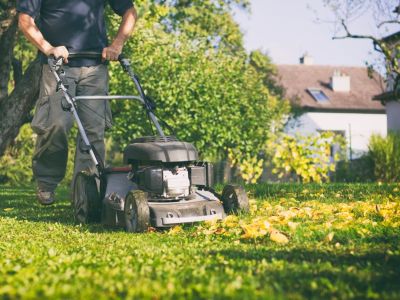Routine Lawn Care: Late Summer
If you slowed or stopped basic lawn care because the grass went dormant during the hottest part of the summer, it’s time to reestablish these routines:
Mowing – As the lawn greens up and begins to grow again, remove approximately 1/3 of the length of the grass blades each week. Regular mowing encourages the formation of side shoots or tillering. This produces a thicker, dense lawn which is more resistant to weeds.Fertilizing – Applying fertilizer when it’s hot can severely damage lawns. Once cool fall temperatures arrive, feed the lawn with a high nitrogen fertilizer to promote growth and assist the turf in preparing for winter dormancy. Weed control – Late summer and fall are the ideal time to eliminate broadleaf weeds like dandelions. As these weeds prepare for winter, they are storing energy in their roots. Herbicides applied in the fall are more easily transported to the roots where these chemicals are most effective at killing the weed.
Additional Late Summer – Early Fall Lawn Care Tasks
In most areas, late summer and early fall provide the ideal window to perform lawn care tasks designed to make the lawn healthier, thicker and better able to withstand stress. Consider tackling these turf maintenance tasks this year:
Thatch removal: Thatch refers to the buildup of plant materials between the surface of the soil and the blades of the grass. Thatch can disrupt the flow of rainwater to the soil’s surface. This encourages grass to root in the thatch layer rather than the soil. Experts recommending dethatching the lawn every five years.
It’s advisable to schedule a dethatching project at least one month before cold weather is expected. This allows the turf to recover before entering winter dormancy. Applying a late summer lawn fertilizer and reseeding after dethatching will help the lawn recover faster.
Aeration: A core aerator has hollow tubes which can remove cores or plugs of soil and turf. This helps reduces soil compaction and promotes better movement of water and nutrients into the substrate. Heavy clay soils often benefit from yearly aeration.
A core aerator works best when the ground is moist, but not soggy. After aerating, apply a late summer lawn treatment of limestone as it can more easily penetrate the soil at this time. Then mow or drag a weighted section of metal fencing over the turf to break up the cores. Apply a high nitrogen fertilizer and reseed as needed.
Reseeding: Due to reduced competition from weeds, grass seedlings have an easier time becoming established when planted in late summer or early fall. This can be a yearly task performed where disease, insects or annual weeds have left areas of the lawn thin or barren.
Prior to reseeding, work the area by raking away dead plant debris. Choose a cool season grass such as Kentucky bluegrass, red fescue or perennial rye, then spread it according to package instructions. Keep the surface of the soil moist during germination and give the new grass 4 to 8 weeks to become established before mowing.
Note: Any recommendations pertaining to the use of chemicals are for informational purposes only. Chemical control should only be used as a last resort, as organic approaches are safer and more environmentally friendly.
